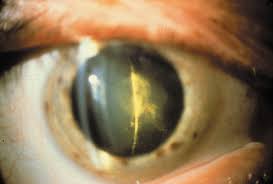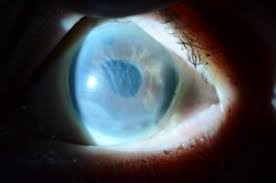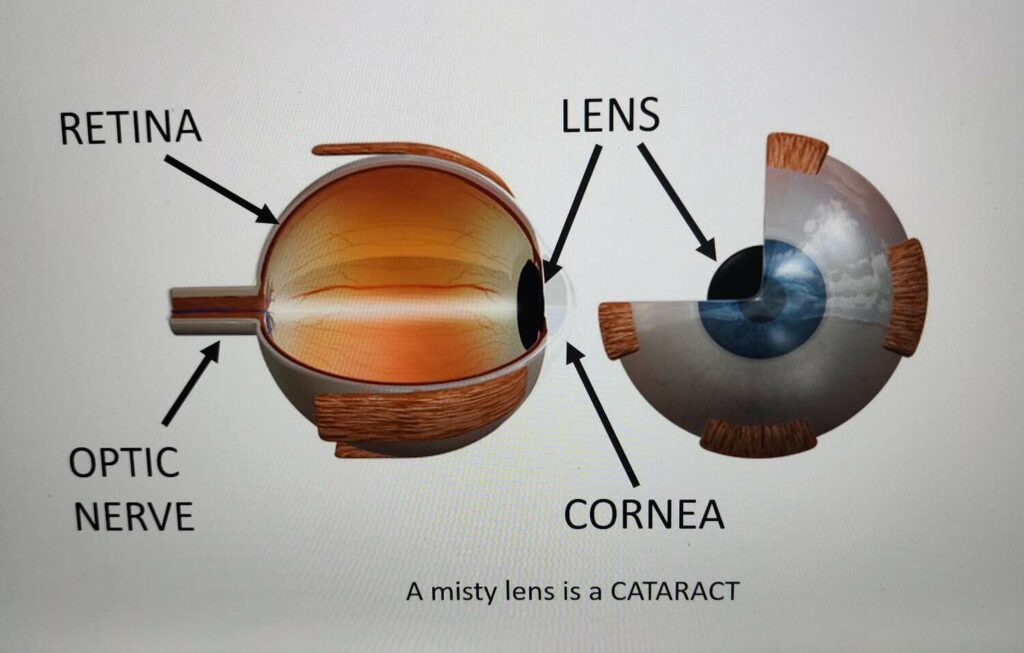If you are experiencing vision problems, it is important to get them checked out by an eye doctor as soon as possible. One common problem that can occur is central cataracts. Many people wonder if their cataract is just due to getting old and have it fixed to help them enjoy better vision and avoid complications later in life. What are the symptoms of central cataracts? How do they get it fixed? How long will it take? These are all questions many people ask. In this article, you can find out what the symptoms are and how to get your treatment started!
Contents
What Is a Central Cataract?
 A central cataract is a type of cataract that affects the area near the center of the lens in your eye. It causes a decrease in vision, often leading to blurred or cloudy vision. This type of cataract can also cause light sensitivity and glare. This is a condition in which the lens of your eye becomes cloudy. In most cases, central cataracts can be treated successfully with surgery.
A central cataract is a type of cataract that affects the area near the center of the lens in your eye. It causes a decrease in vision, often leading to blurred or cloudy vision. This type of cataract can also cause light sensitivity and glare. This is a condition in which the lens of your eye becomes cloudy. In most cases, central cataracts can be treated successfully with surgery.
As cataracts develop, they take over the central region of the eye lens. Initially, the lenses become thicker and harder. With time, they turn yellowish in color. In more advanced cases, the lenses may appear brown. People with cataracts often see objects as blurred or dull.
There are various symptoms. They are blurriness of vision, decreased contrast sensitivity, light sensitivity, glare, and difficulty with nighttime driving. People may also complain of double vision or halos around lights. The most common symptom is a decrease in clarity of vision due to the clouding of the lens.
Are Cataracts Central Or Peripheral?

Surgery is the go-to solution for patients with cataracts and it has a more than 95% success rate in restoring vision. Although this treatment option comes with minimal complications, central vision is generally impacted while peripheral vision may be spared. When glaucoma becomes an issue, however, it mainly affects one’s peripheral sight. It is then important to differentiate between the two types of cataracts – central and peripheral.
A central cataract occurs at the center of your vision, which can lead to difficulty focusing on near objects and a decrease in contrast sensitivity, color perception, and sharpness of vision. Peripheral cataract affects one’s side vision, making objects appear less clear and colors appear faded.
Cataracts are a type of eye condition that is most common in older adults. They affect the lens, which slowly takes on a yellowish hue over time and may even fade to or become brown. As the condition progresses, you see objects blur or seem dull or muddled.
Effect on vision and other associated symptoms
Central cataracts are a type of eye disease that can cause blurry vision and other associated symptoms. Central cataracts form in the middle of the lens inside your eyes. The lens is a clear, curved piece of tissue that helps us see clearly. When central cataracts form, the lens starts to break down. This can cause blurry vision, eagle-eyed accuracy, and even blindness in some cases. In some cases, central cataract symptoms may only become apparent after age 50 or 60. However, central cataracts can affect anyone at any age. Central cataracts usually develop slowly over time and don’t always require treatment. If you’re noticing signs or symptoms of central cataracts, talk to your doctor about getting it checked out. There are many treatments available for central cataract patients, including surgery and medications.
How Do You Know If You Have Central Or Peripheral Vision?
Central cataracts are a common type of cataract, and they’re usually caused by age or by damage to the lens of your eye. Symptoms associated with central cataracts may include seeing objects more clearly in the center of your vision than on the periphery, blurred or distorted vision, difficulty reading and driving, and decreased clarity when looking at objects close up. The most common type of cataract is age-related and it is divided into 3 types based on the anatomy of the human lens. There are central, sclerotic, cortical, and posterior subcapsular cataracts.
The Amsler grid test is a quick and easy way to check if you have any blind spots or changes in your vision. To do the test, hold the chart about 14 inches away from your face and take a close look at it. Check each eye separately by holding the paper close to one eye while keeping the other eye closed. If you notice any blurred or missing areas, this could be a sign that you have central vision loss.
If you have symptoms that indicate you may have a central cataract, see an eye doctor for a diagnosis. If the diagnosis is confirmed, your doctor will likely recommend surgery to remove the lens of your eye.
What Causes Central Cataracts?
There are various causes of central cataracts
- Age-related: One of the most common causes of central cataracts is simply age-related. As people grow older, their lenses naturally start to become cloudier.
- Injury: Trauma or injury to the eye can also cause a cataract to form in the center of your lens. This type of injury might occur due to a physical blow to the eye, or during certain surgical procedures.
- Diabetes: Diabetes is another risk factor for developing cataracts due to a buildup of sugar in your lenses.
- Other medical issues: Various other medical conditions, such as glaucoma, high blood pressure, and autoimmune diseases can increase your risk of developing central cataracts.
Diagnosis
Central cataracts can be diagnosed during an eye exam, during which the doctor will examine the lens of the eye. The doctor may use a slit lamp to get a better look at the lens and its opacity. In addition, they may measure your visual acuity to see how it is affected by the cataract. For instance, if the cataract is obstructing your vision, they may prescribe glasses or contact lenses to help you adjust.
Central cataracts are a type of eye disease that can occur in either the front or back of the eye. They’re caused by a buildup of crystals in the lens of the eye, which causes gradual loss of vision. Central cataracts are most common in older people, but they can also occur in younger adults. The symptoms depend on which part of the eye is affected:
If the cataract is in the front part of the eye, you may experience difficulty seeing close up and difficulty reading. If it’s in the back part of the eye, you may experience blurred vision and sensitivity to light.
How Are Central Cataracts Treated?
Surgery is the only option for the treatment of central cataracts, and it involves removing the clouded lens and replacing it with an artificial one. There are two types of surgery you can have:
Phacoemulsification
Also known as “small incision” surgery, this is a type of cataract surgery that requires only a very small incision in your eye. An ultrasound probe breaks up your natural lens into tiny pieces and then removes them from the eye.
Extracapsular extraction
This surgical procedure also involves removing the cloudy lens, but it requires larger incisions than phacoemulsification. It is a bit more complex than the former, but it can be done in cases where your cataract is too advanced for phacoemulsification.
Regardless of which surgery you choose, you will need to wear an eye patch and use the prescribed medication to ensure that the healing process goes as smoothly as possible. Afterward, you will need to monitor your eyes regularly and use protective eyewear when outdoors.
Central cataracts can be traumatic and life-altering, but they do not have to ruin your vision permanently. With the right treatment and preventative measures, you can regain clear vision and protect yourself from further damage. Be sure to talk to your doctor about the best treatment options for you.
Prevention Tips
There are various prevention tips:
- Wear sunglasses outdoors to protect your eyes from the sun’s UV rays.
- Get regular eye exams, as early detection and treatment can help prevent further vision loss.
- If you have certain medical conditions like diabetes or hypertension, make sure to monitor them closely as they can increase your risk of central cataracts.
- Eat a healthy diet that is rich in antioxidants, like fruits and vegetables. This can help protect your eyes from oxidative damage.
- Avoid smoking or being around second-hand smoke, as this increases the risk of developing central cataracts.
- If you take certain medications for medical conditions such as glaucoma, be sure to take them as prescribed by your doctor.
- If you are over the age of 40, have regular check-ups with your eye care professional to monitor for any changes in vision.
- Finally, be sure to get plenty of restful sleep, as this can help reduce the risk of developing central cataracts. By following these prevention tips, you can help protect your eyes from damage and reduce your risk of developing central cataracts. If you have any questions or concerns about your vision health, be sure to talk to your doctor.
Conclusion
It may be concluded that central cataract is a common, yet treatable condition. If left untreated, it can lead to significant vision loss and other ocular problems. Treatment usually involves surgery, with the goal of restoring the patient’s vision. Depending on the severity of the cataract and its progression, different types of surgery may be recommended by an ophthalmologist. In addition to surgery, lifestyle adjustments such as wearing appropriate eyeglasses and avoiding bright lights may also be recommended to reduce the effects of central cataracts.
With proper treatment, central cataracts can be managed effectively and vision loss prevented or minimized. In any case, regular visits to an ophthalmologist are important for monitoring the progression of the condition and ensuring that the appropriate treatment is used.
Cataract surgery is a safe and painless procedure. At MantraCare we have a team of experienced eye surgeons, who will be happy to answer any questions on cataract surgery. Call us at +91-9711116605 for any inquiries.
